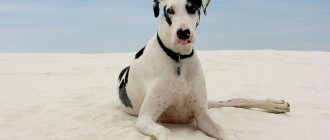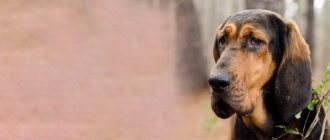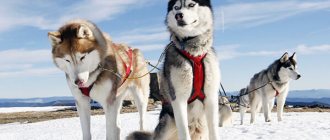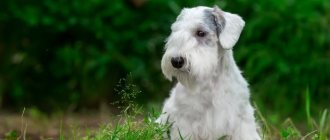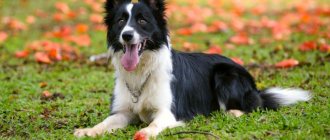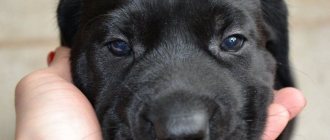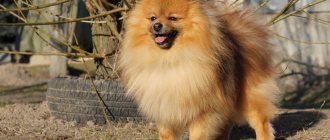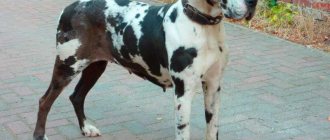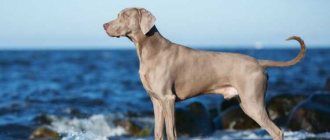At first glance, the Great Dane amazes with its size. This is a truly gigantic dog with an athletic build that looks quite intimidating. However, behind the stern appearance of the representatives of the breed hides a kind and affectionate dog that can become an excellent nanny for children. But before you get such a mighty good-natured dog, you should learn about its characteristics, nuances of care and education.
Brief history of origin
The ancestors of Great Danes are considered to be Bullenbeissers (an extinct breed of the Molossian type) and a group of hunting dogs used in the Middle Ages for baiting large ungulates. These dogs combined the characteristics of powerful mastiffs and fast, agile greyhounds.
At first, the dogs had many differences. They had different sizes, builds and colors. In 1878, German breeders began targeted selection to create a single breed. 2 years later, the first standard was presented at an exhibition in Berlin.
Speaking of health
It leaves much to be desired for Great Danes. Their immunity is weak and their metabolism is slow. These dogs suffer from a large number of ailments. Therefore, regular visits to the veterinarian are necessary.
On average, Great Danes live about 8 years, but with proper care and attention this period can be extended by 3-4 years.
The main diseases that dogs most often suffer from are problems with the intestinal tract (bloating, constipation, volvulus), bone diseases (dysplasia, scoliosis), and osteochondrosis.
Keeping such a breed in a healthy condition and long life costs its owners a pretty penny. And trips to the clinic, and the medications themselves, and following diets are not cheap. But this will not outweigh the love, devotion and affection that these delightful Apollos with a huge kind heart give.
Interesting Facts
There are many interesting facts associated with representatives of this breed:
- Before the introduction of the official standard, the breed had several names: English, Great, Ulm, Great Dane, Boar or Hound dog.
- In the second half of the 19th century, Great Danes were declared the national breed of Germany.
- The modern breed standard has awarded the Great Dane the title of “Apollo of the canine world.”
- Great Danes were the property of aristocrats - they were kept in palaces as guards. Therefore, the breed is often called the Royal Dane.
- The dog named Scooby-Doo from the cartoon of the same name was a Great Dane. However, the character's cowardly nature has nothing in common with real representatives of the breed.
- The Great Dane Zeus from Michigan is listed in the Guinness Book of Records as the largest dog in the world. His height is almost 112 cm and his weight is more than 70 kg. He took over this title from the dog Giant George, who weighed 111 kg and had a height of 109.2 cm. Unfortunately, the giant died in August 2009.
- Fans of the breed were the first Chancellor of the German Empire, Otto von Bismarck, and Emperor Alexander II.
- In August 2022, the King of Thailand, Maha Vajiralongkorn, took under his protection and fed 13 Great Danes who were dying of hunger. The dogs belonged to a female breeder. She went bankrupt and had nothing to feed the animals.
Expert opinion
Leonid Rodin
Experienced dog breeder
Ask a Question
Many dogs were enlisted in military service and distinguished themselves in military affairs. But the story of the Great Dane, nicknamed Just Nuisance (“just hesitated”) - although he was given the name Pride at birth - stands out even against the background of these heroic stories. The dog became friends with the sailors from the cruiser Neptune and often lay down near the gangway, not allowing strangers on board. It was not possible to step over the huge dog, and the sailors rewarded the Great Dane with phrases like “he hesitated,” although they loved him and fed him. Later, he began to travel with the sailors to Cape Town and sometimes dragged friends who were tipsy on leave back to the ship. Since the railway workers did not want to transport a large stowaway dog, the base commander issued an order to enlist the Great Dane in the Royal Naval Service with the rank of sailor of the first class. And the first and last names in this document were designated Just Nuisance. The dog, like people, went to formations and on guard duty. Once, a four-legged sailor even saved the life of an aircraft mechanic who lost consciousness during an attack of malaria. Towards the end of his life, the Great Dane became addicted to alcohol, which is why the base commander wrote an appeal to the owners of drinking establishments. In it, the officer asked not to pour more than 6 glasses of beer for the dog, since it cannot refuse drinking on its own. The legendary sailor “Zakolebal” died in 1944 at the age of 7 and was buried in a military cemetery. And later a monument was erected in Simonstown: a huge, life-size Great Dane made of bronze stands on a piece of rock. At the dog’s feet lie a collar and a sailor’s cap. There is also a sign here: “Able seaman (sailor of the first article) Just Nuisance, 1937-1944.”
General characteristics of Great Danes as a breed
Great Danes are one of the largest dogs. Their height can reach 110 cm, and some representatives of the breed weigh more than 90 kg. But despite their enormous size, Great Danes are not evil. These are calm, intelligent and very loyal animals. They do not show aggression and are quite sociable. Although this is an excellent guard and watchman, when danger arises, it boldly rushes to protect the owner and his property.
The Great Dane is also popular because of its elegant, beautiful appearance. This is an aristocrat and even the Apollo of the dog world. For this reason, the breed is often called the Royal Dane.
The main characteristics of the Great Dane are independence, good nature, calmness, and intelligence. The breed can be used as a bodyguard, guard, watchman, in guard and escort service. But it is also a wonderful companion, devoted friend, nanny and protector for the child. These dogs are ideal for large families, respectful of people and easy to train.
The photo shows that Great Danes are huge but good-natured dogs:
Walking with a little girl
Huge Great Dane
Great Dane with a child
| Options | Characteristic |
| breed name | Great Dane, Royal Dane |
| country of origin | Germany |
| time of adoption of the first standard | 1880 |
| group of breeds according to the ICF classification | Molossians, mastiff subsection |
| height | males 80-90 cm, females 72-84 cm |
| weight | males 63-79 kg, females 50-63 kg |
| life expectancy | 8-10 years |
| usage | watchman, security guard, companion |
| character traits | calm, loyal, fearless, good-natured, intelligent, reliable, cheerful |
| aggressiveness | do not show aggression, get along well with other pets |
| activity | tall, needs long walks with running and outdoor games |
| intelligence | smart |
| training | uncomplicated |
| attitude towards people | friendly, loyal, love children, suspicious of strangers |
| need for communication | sociable, do not tolerate loneliness well |
| health | weak, live on average 5-7 years |
| care | easy, moderate shedding |
Pros of the breed
Great Danes are popular dogs for families with children and active young people. The breed is suitable even for inexperienced owners, as it is non-aggressive and easy to train. These pets have many advantages:
- balanced psyche;
- obedient, calm character;
- unobtrusive, intelligent behavior;
- impressive, beautiful appearance;
- rarely bark;
- devotion, sociability, good nature;
- high intelligence;
- no aggression towards strangers and other animals;
- are a good companion, ready to accompany the owner everywhere;
- can become a nanny and a reliable protector for a child;
- short hair, sheds lightly.
Cons of content
But these pets have serious disadvantages. Due to their height, Great Danes are difficult to keep in a city apartment. They are not suitable for very busy people, as they require a lot of attention and do not tolerate loneliness well. There are several other disadvantages of the content:
- requires a lot of space in the apartment for sleeping and playing;
- cannot be kept in an enclosure;
- Because of their short fur they get cold in winter;
- large weight and size can become a problem during active games, the dog can accidentally cause injury;
- high consumption of products;
- poor health, Great Danes rarely live longer than 8 years;
- high physical activity required;
- increased salivation.
The video complements the information about the pros and cons of Great Danes:
Video: Great Dane
Video: Great Dane pros and cons of the breed
Interesting facts about the Great Dane breed
This is a young breed that appeared in the 19th century, although such large dogs have served people since ancient times. A lot of interesting facts about Great Danes have accumulated.
- Great Danes are giant dogs. For their height they are included in the Guinness Book of Records. A Great Dane named Zeus had a height at the withers of 110 cm, and when he stood on his hind legs, the height of this giant reached 220 cm. And the dog George, with a height of 109 cm, weighed more than 100 kg.
- Sometimes you can find the name “Royal Great Dane”. The dogs are called this because of their enormous size, but they are the same breed.
- Many people know the breed thanks to the cartoon about Scooby-Doo - a funny and cowardly Great Dane. Although in fact real dogs do not look like this character.
- In ancient times, similar dogs were found in all countries. They took part in dog fights, helped people in war, and guarded property. In England they were used for hunting. But the breed is called German, since the first standard was developed in Germany.
- In Russia, the Great Dane appeared even before the revolution, but was not popular. During World War II, all dogs of this breed were destroyed.
- These dogs have the shortest life expectancy. Even in favorable conditions, they live on average 6.5-7 years.
Pictures from the Internet show what an interesting dog the Great Dane is:
Great Dane and Chihuahua
Three merle Great Danes
Got bored
Can drink water on his own
Great Dane and cat
Breed description, standards and appearance
The Great Dane is a giant dog, expressing nobility, grace and power with its entire appearance. The animal has a not very massive, but not overly light body - everything is in complete harmony.
The size of the Great Dane is indeed very impressive.
The breed standard specifies the ideal height at the withers:
- 80-90 cm for boys;
- 72-84 cm for girls.
Height at the withers below the permissible level is a disqualifying fault.
There is no weight limit for dogs. It can range from 50 to 80 kg. However, the Great Dane should always look harmonious.
Experts pay special attention to the ratio of body length and height at withers. For boys, an almost square format is important; for girls, a slightly elongated physique is acceptable.
Description of the Great Dane dog breed (ICF standard No. 235):
- The head is large, elongated, dry, with straight features. Fits harmoniously into the dog's appearance. When viewed from the front, it looks slightly flattened on the sides. A wedge-shaped head is unacceptable. The stop is clearly marked, dividing the head approximately in half.
- The nose is large, with large nostrils, and painted black. Marbled Great Danes may have light pigmentation, while blue ones may have grayish pigmentation (wet asphalt). A brown nose is a disqualifying fault.
- The muzzle is deep and rectangular in shape. The bridge of the nose is without bulges and depressions. The upper lip is drooping and covers the lower jaw. It should not be short or excessively fluttery. Lip color is dark. Marbled Great Danes are not penalized for incomplete pigmentation or flesh color.
- The jaws are wide, with 42 strong white teeth. Closed in a scissor bite. Any other form of malocclusion is a disqualifying defect.
- The eyes are medium-sized, almond-shaped, with adjacent eyelids. As dark an iris pigmentation as possible is encouraged. Great Danes have a light blue color; in merle dogs, lightening and heterochromia are possible. Translucent and amber eyes are highly undesirable.
- The ears are medium to long, naturally drooping, and set high on the head. The anterior edges of the ear tissue touch the cheeks.
- The neck is of moderate length, dry, with developed muscles. The topline is curved. An abundance of loose skin and dewlap are not welcome.
- The withers are the highest point of the body. The back is short, level or slightly sloping towards a strong, slightly prominent loin. The croup is wide, slightly sloping from the sacrum to the base of the tail.
- The chest is oval, of good width and depth, falling to the elbows. The belly is tucked in, but not excessively. The bottom line curves smoothly.
- The tail is wide at the base and set high. In a calm state it touches the hock joints, in an alert state it takes the shape of a saber. A hooked, curled, raised above the topline or bushy tail is not acceptable. Great Danes with deformed vertebrae resulting in a kinked tail will be disqualified.
- The limbs are straight, muscular, with good angles, strong bones. The paws are rounded, the toes fit tightly to each other. The claws are short and as dark as possible.
Representatives of the breed move freely and slightly springily, capturing space well. When viewed from the front, the legs move in parallel. Mincing gait and ambling are unacceptable.
Important. Aggressive and cowardly Great Danes, individuals with a low threshold of irritability, and representatives of the breed with physical and behavioral abnormalities are subject to disqualification.
Varieties of colors
The body of the Great Dane is covered with elastic skin, which is colored to match the color of the coat. In merle dogs, the pigment is distributed according to the markings.
Representatives of the Great Dane breed have short, thick, shiny fur. These dogs are bred in three distinct color varieties.
| Color group | Characteristic |
| Brindle and fawn | Brindle – on a golden background there are black stripes scattered along the ribs. Tigers must have clear boundaries. A dark mask is not recommended. There are no light marks. |
| Fawn – any shades from beige to reddish are acceptable. It is advisable that there is no dark mask on the face. Impurities of blue, brown and gray colors are unacceptable. There are no light marks. | |
| Black and marble | Black is a rich, deep color that shimmers beautifully in the sun. There may be white spots on the paws and chest. This color also includes 2 more types: |
| 1. Raincoat: the lower part of the body is white, there is a white blaze on the head. | |
| 2. Platen (spotted): large rounded black markings scattered across a white background. Impurities of brown and fawn, as well as a bluish tint, are unacceptable. | |
| Marble (harlequin) - black spots of irregular shape are arranged in a chaotic manner on a white background. Gray and brownish markings, as well as bluish-gray speckling, are highly undesirable. Dogs with dark spots on a gray background are not welcome, but will not be disqualified. All-white Great Danes (albinos), dogs with blue, fawn or brindle markings are removed from exhibitions. | |
| Blue | The Blue Great Dane has a uniform grayish-blue coat color. There may be white spots on the paws and chest. If they are on the forehead, neck, tip of the tail or above the pasterns, the Great Dane will be disqualified. Defects include fawn and bluish-black shades. |
Great Danes can only be bred within one group. That is, crossing, for example, black and blue dogs is prohibited. This leads to the appearance of atypical colors that do not correspond to the breed standard.
You can learn more about the colors of the breed in the article “Types of colors of the Great Dane.”
The most popular colors
The Great Dane is characterized by shiny, smooth fur and dense skin with bright pigment. Based on color, the breed is conventionally divided into three groups: fawn, harlequin and blue.
Pale yellow
It is usually a uniform color ranging from pale to deep gold. According to standards, a black mask is preferable. Additional spots in this color are not welcome, although they are possible.
Marble
This group includes two colors - merle and brindle. Brindle corresponds to fawn in all respects (shades and spots), but the presence of even black stripes in the direction of the ribs is mandatory.
The merle color is characterized by a general white background, on which ragged black spots are unevenly located. The general background in this case can be gray, but this color is less preferable.
Blue
There are also two options here: directly blue and black.
If we talk about black, then it is necessary to note its depth and richness. In the black color, the presence of white spots in different combinations is allowed - marked, spots, etc. The blue color is characterized by a steel tint, white spots are also allowed, only fawn and black shades on the coat are rejected.
Character and behavior
Representatives of the breed have a reasonable, calm and friendly character. Puppies are mischievous and playful, but become more sedate with age.
These dogs become strongly attached to the owner and his entire family, and treat children with tenderness. They need regular communication with a person, they get bored and mope when alone. This characteristic of the breed makes it an excellent companion.
Dogs of this breed make excellent protectors and bodyguards. The dog vigilantly monitors everything that happens, hiding his emotions behind a mask of indifference. If he sees that the owner is in danger, he will rush into battle without hesitation.
Socialized Great Danes quickly find contact with other pets and do not conflict with their relatives.
Reproduction and lifespan
Unfortunately, massive and tall dogs do not live long, specifically Great Danes - from 8 to 10 years. Even good care rarely increases their service life. These charming dogs should be brought together according to the rules. Firstly, individuals aged from 2 to 6 years are suitable for reproduction, as they are capable of producing healthy offspring.
Secondly, it is better to organize mating in the territory of the dog. And thirdly, the male will definitely show sexual interest in the female if she is in heat. The optimal time for mating is the 4th day of the female's menstruation. The reason is the high chances of pregnancy. A Great Dane female bears offspring from 67 to 71 days.
How to choose the right puppy?
When choosing a Great Dane puppy, special attention should be paid to the following points:
- reputation of the breeder - you should study reviews, talk with owners who have already bought puppies from him;
- conditions for keeping dogs - animals must be in clean and spacious enclosures;
- behavior of puppies - healthy babies are active, playful and curious;
- the exterior and character of the parents - they should not have obvious defects in appearance and temperament, since defects can be inherited.
For your information. The larger the paws of a Great Dane puppy, the taller he will grow.
It is not recommended to buy Great Danes from someone else. There is a high probability that the baby is not purebred or sick. Only a purebred dog will have the positive qualities that are characteristic of Great Danes.
When the choice is made, the parties enter into a purchase and sale agreement. The document guarantees the health of the baby and his belonging to this breed of dog. Along with the puppy, the breeder must provide a veterinary passport and birth certificate.
History of the breed
The Great Dane breed is a very ancient breed. 3000 BC in Egypt, during excavations, drawings were found that depict dogs very similar to Great Danes. The same drawings were found in ancient Babylonian temples; these temples arose 2000 BC. Ancient manuscripts dating back to 1121 indicate that the Great Danes were kept by Tibetan monks. They were breeding them, exchanging breeding dogs between monasteries so that new blood would flow in the puppies.
The ancestors of Great Danes are Irish Wolfhounds, English Mastiffs, and Irish Greyhounds. There are suggestions that this is not a complete list of breeds that participated in the formation of the Great Dane. During the time of the Assyrians, who were involved in the dog trade around the world, Great Danes interbred with many other species, so it is impossible to compile an exact list of the Great Dane's ancestors.
Initially, due to their enormous growth and power, they tried to use Great Danes as hunting dogs. Specifically, they were intended for baiting wild boars. It was at that time that the decision was made to crop the ears so that a wild animal could not tear the dog’s ears with its fangs during a fight. But breeders and owners of Great Danes had to admit that they were not adapted to hunting skills.
Therefore, at the end of the 1600s, the Great Dane took a place near the fireplace of its noble owner. It has become prestigious to keep such a large pet in your home. The rich owner spared no expense on the collar for his Great Dane; they were decorated with precious stones, which indicated wealth and a high place in society for the owner of the huge dog.
The modern appearance of the Great Dane was formed thanks to the great contribution of German breeders. It is thanks to their work that the Great Dane looks somewhat extravagant; this dog is tall, slender with a proud gait. When forming the breed, they sought not only a beautiful appearance, but also a certain form of behavior. As a result, the Great Dane has a friendly and flexible character; the high level of aggression that was present in the ancestors has been tamed.
In 1880, at a Berlin conference, the name of the breed “Great Dane” was officially approved. The first Great Dane club was also founded in Germany. Then representatives of the breed gradually spread throughout all countries of the world and gained popularity.
Caring for puppies
Before bringing a puppy into the house, you should arrange a soft bed in a quiet place. You will also need:
- bowls for food and water;
- collar, leash and muzzle;
- care products;
- toys of different shapes and sizes;
- disposable diapers (until the puppy learns to relieve himself outside).
At first, the baby is fed the foods that he is used to eating from the breeder. Gradually, the diet is enriched with new foods: offal, sea fish, kefir, cottage cheese.
For your information. During the change of teeth, puppies of this breed are given calcium supplements.
Portions are gradually increased, and the frequency of feedings is reduced. There is no need to overfeed the puppy. After eating, his stomach should not become very bloated.
The number of feedings per day depends on the age of the dog:
- up to 2 months – up to 6 times;
- from 2 to 3 months – 5 times;
- from 3 to 5 months – 4 times;
- from 5 to 15 months – 3 times.
From the age of 15 months, a Great Dane pet can be switched to two meals a day. However, the complete formation of the body is completed only by 20-24 months.
Important. Increased physical activity is contraindicated for growing dogs. They cause problems with joints and ligaments.
Possible diseases
There are no specific diseases unique to this breed. But Great Danes get sick no less than other dogs; most often they suffer from the following ailments:
- joint problems – dysplasia, osteochondrosis;
- heart disease - cardiomyopathy;
- ear diseases – otitis media, ear mites;
- infectious enteritis - affects the liver and digestive system;
- ulnar bursitis - a neoplasm in the form of a tumor, appears due to sleeping on a hard surface;
- volvulus of the stomach.
You should not self-medicate your dog. Some diseases, such as gastric volvulus, are fatal if you do not seek help from a veterinarian in a timely manner.
Care and maintenance of an adult dog
It is preferable to keep Great Danes in a large private house. It will be too crowded for huge dogs in an apartment, and their short hair does not allow them to stay in the yard all the time.
The right diet
The Great Dane can be given balanced ready-made food of premium and superpremium classes or holistic level.
With a natural diet, the basis of the diet is lean meat and offal. A dog will need about 600-800 g per day.
The norm is determined in accordance with the size and level of physical activity of the pet.
The menu also includes:
- rice, oatmeal and buckwheat porridges;
- dairy products;
- fresh herbs, vegetables and fruits;
- sea fish and eggs (1-2 times a week).
Food from the master's table, any salty, fatty, fried, smoked food, sweets and baked goods are prohibited.
Important. If your Great Dane is getting fat, you need to reconsider its diet. Extra pounds are fraught with serious health problems.
Walking and physical activity
Great Danes require moderate intensity physical activity: running uphill, swimming, towing. Dogs are walked twice a day for at least 1 hour.
Training and education
The Great Dane dog breed has a sharp mind and excellent memory, so it is quite easy to train. It is important to start training as early as possible - puppies absorb new information like sponges.
As a child, the dog is actively socialized: introduced to the outside world, other people and animals. Thanks to this, an adult Great Dane will behave adequately in any situation.
Initial training is carried out in a playful way so that the puppy does not lose interest. Gradually move from simple to complex, adding endurance exercises and gestures.
The owner must act harshly, but not cruelly. Physical violence leads to disobedience, and can even break the pet’s psyche. If the dog follows orders, it is praised and given a treat.
Care and hygiene
Great Danes are brushed once a week, and during the shedding period - once every 2-3 days. Bathing is required only in case of severe pollution, but not more than once a quarter.
Important. A Great Dane puppy should get used to all hygiene procedures from childhood. It will be extremely difficult to restrain an adult dog if it begins to resist.
Caring for this dog breed includes:
- cleaning ears, rubbing eyes – once a week;
- trimming claws - approximately once a month;
- brushing your teeth – 1-2 times a week;
- worming – once every 3 months;
- treatment against blood-sucking parasites - depending on the brand of the product.
After walks, dogs' paws are washed. If the pads are cracked, rub vegetable oil into them.
Conditions of detention
The Great Dane is more suitable for keeping in a private home. This dog needs a lot of space and will feel uncomfortable in small spaces.
Representatives of the breed are quite energetic, so they require daily walks, the total duration of which should be at least two hours.
Vaccinations and susceptibility to disease
Great Dane puppies receive their first comprehensive vaccination at 8-9 weeks. After 2-3 weeks, the vaccine is reintroduced to strengthen immunity. At about six months, when the change of teeth ends, dogs are vaccinated against rabies.
The next vaccination is given at 12 months, after which it is repeated annually.
Great Danes cannot boast of excellent health. These dogs are prone to many diseases:
- volvulus;
- hip dysplasia;
- cervical spondylopathy (pathology of the nervous system);
- osteochondrosis;
- osteosarcoma (malignant bone tumor);
- cardiomyopathy;
- aortic stenosis;
- hypoadrenocorticism (pathology of the endocrine system);
- hypothyroidism;
- demodicosis;
- skin histiocytoma (benign tumor);
- pododermatitis;
- otitis;
- deafness;
- cataract;
- turn of the century.
The average lifespan of a Great Dane is 7-9 years.
Ear cropping
Previously, ear cropping was a mandatory procedure for all Great Danes. Its purpose is to protect against injury during hunting.
Now dogs play the role of companions, so there is no need for surgery. In addition, in many countries there is a ban on cupping - the procedure is considered inhumane.
The breed standard, in force since 1993, states that the ears must remain natural. According to veterinarians, a long ear flap better protects against dust, insects and infections.
In Europe, dogs with cropped ears are not allowed to participate in shows. There is no consensus on this matter in Russia yet. Many owners still crop their ears to make the animal look more menacing.
Pros and cons of the breed
| pros | Minuses |
| Balanced and friendly character | Poor health |
| Devotion | Short life expectancy |
| High threshold of irritability | Difficulties with apartment maintenance |
| Good security qualities | |
| Loves children | |
| Does not require complex care |
How much does a puppy cost?
The price of a Great Dane puppy depends on its exterior, title status of the parents, exhibition prospects and the reputation of the kennel. The cost is also affected by color - marbled dogs are more popular than fawn and black.
A puppy with slight deviations from the standard costs 12-20 thousand rubles, and a dog with excellent external characteristics, born from champion dogs, costs 50-70 thousand rubles.
In Moscow, purebred Great Dane puppies are sold in nurseries:
- Inner Light https://www.kennel-dog.com;
- Olrei https://olrei.greatdanes.dog;
- "Adamant Dog" https://www.adamantdog.ru.
For a long time, Great Danes were shepherds, guards and hunters. Now they are loved all over the world as devoted companions.
A person walking next to such a dog will definitely be the center of attention.
Training and education
The Great Dane is an intelligent and quick-witted dog with a good memory, so an experienced owner will not have any problems with training.
Submitting a dog doesn't always work. The principle of complete submission of the Great Dane to the owner is an outdated method. This theory was formulated based on observations of packs of wild wolves, but they were kept in captivity and, of course, experienced stress. The stress condition forced wolves to show aggression towards each other, but in the wild they do not show aggression to each other - they live together and interact with each other. You need to perceive yourself as the more experienced and mature member of the pack, who is responsible for guiding the new member (Great Dane puppy) and teaching him good behavior, as well as correcting him if necessary. It is important to remember that Great Dane puppies learn a lot on their own. They are very inquisitive, love to explore new territories and, of course, experiment. Puppies tend to repeat actions they enjoy (like playing with a toy). They do not repeat actions that cause them pain (for example, destroying a nest and getting bitten). If your Great Dane puppy misbehaves, ignore him and praise him when he does the right thing. Reward your puppy for following commands and good behavior. Do not neglect these tips. After all, constantly hearing “you can’t” all day long is unbearable. This is a small child who wants to know everything and get his portion of treats as a reward for not eating your favorite rug, going to the toilet outside, bringing you a ball, and so on.
Set rules and monitor their implementation
It is worth enrolling your Great Dane puppy in obedience training classes. These classes will allow you to understand exactly what actions will allow you to control your dog’s behavior. You will be able to spend more time with your puppy, establish contact and socialize around other dogs.
Adviсe
- Training a Great Dane puppy should be done with the help of positive motivation; watch carefully special films about this technique. The Canine Translator film series from National Geographic is suitable.
- If you need to leave your puppy at home alone for 2 hours or more, then ask someone to come to him.
- Be sure to schedule your Great Dane puppy's veterinarian appointment as soon as possible. The doctor will carefully examine him and give him vaccinations that will protect him from dangerous diseases.
